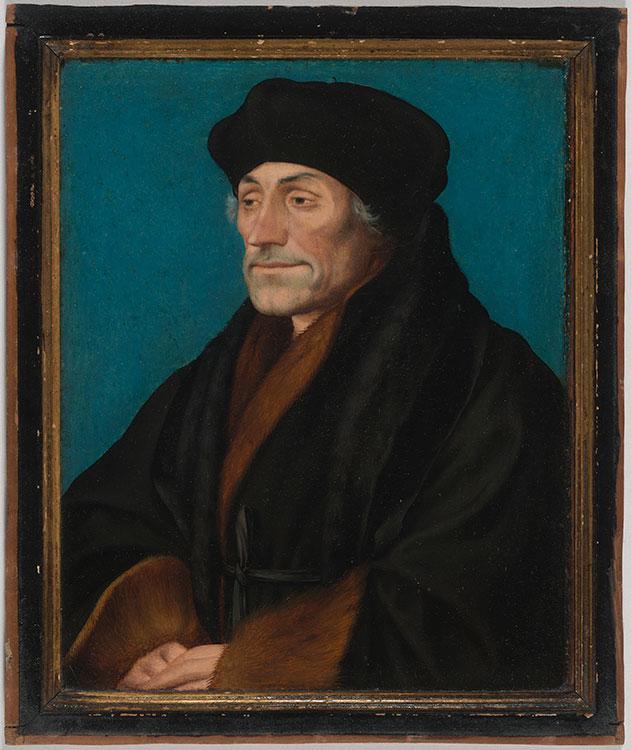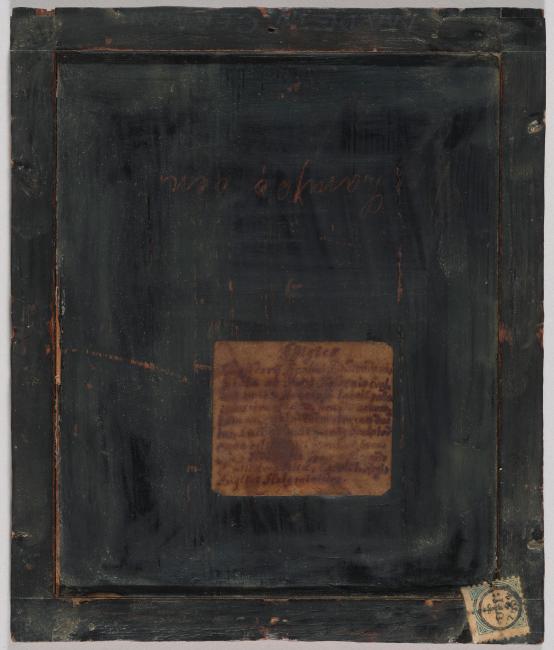

Portrait of Erasmus of Rotterdam
Bequest of Miss Alice Tully.
This small painted panel, done by Hans Holbein the Younger (1497-1543) and his workshop, depicts Dutch humanist and Catholic priest Desiderius Erasmus of Rotterdam (1466-1536). Erasmus was in his lifetime well known for his widely-circulated theological and philosophical texts, some of which were implicated in the 1517 Protestant revolution. An influential and sometimes controversial figure, he was portrayed by some of the period's most notable artists, including his friend Holbein the Younger. The Morgan's Portrait of Erasmus was likely completed in the artist's workshop sometime between 1530 and 1536 and is inspired by a portrait Holbein first painted in 1523 when the two men lived in Basel (the panel, form the Longford Castle collection, is on long-term loan to the National Gallery, London). Carefully observed details-for example, the stubble on Erasmus's chin and his fine fur collar-underscore the close kinship between the artist and his subject.
Erasmus's immense popularity and his fondness for gifting portraits of himself to patrons and supporters prompted Holbein and other enterprising artists to produce many versions of this portrait. The Morgan example contains numerous pentimenti (passages showing changes made to the painting as it was executed) that reveal underdrawing, namely around the nose, eyes, cheekbone, and fingers in the left hand. Such marks suggest the use of a cartoon (or, template) to make the painting. Cartoons both speed up the production process and ensured some modicum of consistency among copies. Such consistency is apparent, for example, in a version of the painting formerly owned by Pierpont Morgan and inherited by his son J.P. Morgan, Jr., and now in the Lehman Collection of the Metropolitan Museum of Art. The Lehman panel closely resembles the Morgan's copy, likewise bears traces of underdrawing, and is thought to be the product of Holbein and his workshop. The Morgan's panel also compares to a version on loan from the Erasmus Foundation to the Museum Boijmans van Beuningen, Rotterdam, dated to ca. 1530-36 and attributed to Lucas Cranach the Elder and workshop. Cranach never painted Erasmus from life but instead used a cartoon based on Holbein's work to recreate the portrait.
The early provenance of this work is not yet known. Various markings and inscriptions appear on the back of the panel, including a cursive inscription in red chalk (now obscured by a layer of blanched varnish) and a largely undecipherable hand-written label, seemingly in Dutch and likely created sometime in the eighteenth or nineteenth century. Also affixed on the back of the panel are several German customs stamps. The picture frame is inscribed, “MADE IN GERMANY,” and a piece of tape appears to contain the date “193(?)”. Such markings suggest the work was at some point in Germany perhaps in the mid-to-late 1930s. Alice Tully, from whom the Morgan received the panel by bequest in 1996, possibly acquired the painting in the 1960s, although not much is yet known about the origins of works in her collection. -Sarah W. Mallory
Perhaps from a private collection, Germany (suggested by German customs stamp on reverse); subsequent ownership history as yet unknown; Alice Tully (1902-1993), New York, possibly acquired in the 1960s.
On reverse, at upper center: indecipherable script in red chalk; above, in black chalk (?): “MADE IN GERMANY”; at lower center: largely indecipherable hand-written script in Dutch on white paper label, a small fragment of tape with “M”(?) and “193(?)” ; at lower right: “ZOLL” stamped in black on small square of white paper; “ZOLL” stamped in black ink directly on the panel.
